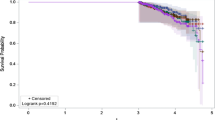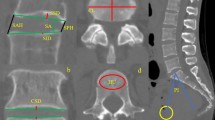Abstract
Purpose
Some patients will experience post-operative back pain following lumbar discectomy, and the potential sources for that pain are poorly understood. One potential source is the vertebral endplates. The goal of this study was to document the changes that occur in lumbar endplates following discectomies, and to assess associations between endplate changes and clinical outcomes.
Methods
Changes in lumbar endplates and discs were assessed from X-rays, CT and MRI exams by comparing preoperative imaging with imaging obtained at yearly intervals up to 5 years. 260 endplates in 137 patients with single-level herniation and discectomy were analyzed. The geometry of osseous defects in the endplates was measured from the CT exams, and marrow and disc changes adjacent to endplates were assessed from the MRI exams. Clinical outcome assessments were collected at each time point. Descriptive statistics were used to describe endplate defect sizes, and logistic regression and analysis of variance were used to identify potential associations between endplate and vertebral body changes and clinical outcomes.
Results
Approximately 14 % of the endplates had osseous defects prior to surgery. After surgery, 24 % of inferior and 43 % of superior endplates had defects. Change occurred within the first year and remained relatively constant over the next few years. Disc signal intensity worsened and disc height decreased following surgery. New Modic changes were also observed. None of these changes were associated with having achieved a clinically significant improvement in outcome scores. The follow-up rates were low at the later time points and significant associations cannot be ruled out.
Conclusions
This study documents lesion characteristics in detail and supports that osseous defects in the endplates at the level of a lumbar discectomy may be a relatively common finding following surgery, along with disc height loss, loss of disc signal intensity, and Modic changes. The clinical significance of these imaging findings could not be conclusively determined in this study.








Similar content being viewed by others
References
Sherman J, Cauthen J, Schoenberg D, Burns M, Reaven NL, Griffith SL (2010) Economic impact of improving outcomes of lumbar discectomy. Spine J 10(2):108–116
Antonacci MD, Mody DR, Heggeness MH (1999) Innervation of the human vertebral body: a histologic study. J Spinal Disord 11(6):526
Brown MF, Hukkanen MV, McCarthy ID, Redfern DR, Batten JJ, Crock HV, Hughes SP, Polak JM (1997) Sensory and sympathetic innervation of the vertebral endplate in patients with degenerative disc disease. J Bone Jt Surg Br 79(1):147–153
Wang Y, Videman T, Battié MC (2012) Lumbar vertebral endplate lesions: prevalence, classification, and association with age. Spine 37(17):1432–1439
Bonneville JF, Runge M, Cattin F, Potelon P, Tang YS (1989) Extraforaminal lumbar disc herniations: CT demonstration of Sharpey’s fibers avulsion. Neuroradiology 31(1):71–74
Schmid G, Witteler A, Willburger R, Kuhnen C, Jergas M, Koester O (2004) Lumbar Disk Herniation: correlation of Histologic Findings with Marrow Signal Intensity Changes in Vertebral Endplates at MR Imaging 1. Radiology 231(2):352
Veres SP, Robertson PA, Broom ND (2008) ISSLS prize winner: microstructure and mechanical disruption of the lumbar disc annulus: part II: how the annulus fails under hydrostatic pressure. Spine 33(25):2711
Veres SP, Robertson PA, Broom ND (2010) ISSLS Prize Winner: how loading rate influences disc failure mechanics: a microstructural assessment of internal disruption. Spine 35(21):1897
Veres SP, Robertson PA, Broom ND (2010) The influence of torsion on disc herniation when combined with flexion. Eur Spine J 19(9):1468–1478
Veres SP, Robertson PA, Broom ND (2009) The morphology of acute disc herniation: a clinically relevant model defining the role of flexion. Spine 34(21):2288
Malinin T, Brown M (2007) Changes in vertebral bodies adjacent to acutely narrowed intervertebral discs: observations in baboons. Spine 32(21):E603
Rätsep T, Minajeva A, Asser T (2013) Relationship between neovascularization and degenerative changes in herniated lumbar intervertebral discs. Eur Spine J 22:2474–2480
Babar S, Saifuddin A (2002) MRI of the post-discectomy lumbar spine. Clin Radiol 57(11):969–981
Barth M, Diepers M, Weiss C, ThomÈ C (2008) Two-year outcome after lumbar microdiscectomy versus microscopic sequestrectomy: part 2: radiographic evaluation and correlation with clinical outcome. Spine 33(3):273
Grand C, Bank W, Baleriaux D, Matos C, Levivier M, Brotchi J (1993) Gadolinium enhancement of vertebral endplates following lumbar disc surgery. Neuroradiology 35(7):503–505
Oetgen M, Yue J, Jaramillo-de la Torre J, Bertagnoli R (2008) Does Vertebral Endplate Morphology Influence Outcomes in Lumbar Total Disc Arthroplasty?: Part II: Clinical and Radiographic Results as Evaluated Utilizing the Vertebral Endplate Yue-Bertagnoli (VEYBR) Classification. SAS J 2(2):101–106
Pfirrmann CW, Metzdorf A, Zanetti M, Hodler J, Boos N (2001) Magnetic resonance classification of lumbar intervertebral disc degeneration. Spine 26(17):1873–1878
Modic M, Masaryk T, Ross J, Carter J (1988) Imaging of degenerative disk disease. Radiology 168(1):177
Zhao KD, Yang C, Zhao C, Stans AA, An KN (2005) Assessment of non-invasive intervertebral motion measurements in the lumbar spine. J Biomech 38(9):1943–1946
Copay AG, Glassman SD, Subach BR, Berven S, Schuler TC, Carreon LY (2008) Minimum clinically important difference in lumbar spine surgery patients: a choice of methods using the Oswestry Disability Index, Medical Outcomes Study questionnaire Short Form 36, and pain scales. Spine J 8(6):968–974
Hilton RC, Ball J, Benn RT (1976) Vertebral end-plate lesions (Schmorl’s nodes) in the dorsolumbar spine. Ann Rheum Dis 35(2):127–132
Peng B, Wu W, Hou S, Shang W, Wang X, Yang Y (2003) The pathogenesis of Schmorl’s nodes. J Bone Jt Surg Br 85(6):879
Pfirrmann CW, Resnick D (2001) Schmorl nodes of the thoracic and lumbar spine: radiographic-pathologic study of prevalence, characterization, and correlation with degenerative changes of 1,650 spinal levels in 100 cadavers. Radiology 219(2):368–374
Saluja G, Fitzpatrick K, Bruce M, Cross J (1986) Schmorl’s nodes (intravertebral herniations of intervertebral disc tissue) in two historic British populations. J Anat 145:87
Silberstein M, Opeskin K, Fahey V (1999) Spinal Schmorl’s nodes: sagittal sectional imaging and pathological examination. Australas Radiol 43(1):27–30
Girard C, Schweitzer M, Morrison W, Parellada J, Carrino J (2004) Thoracic spine disc-related abnormalities: longitudinal MR imaging assessment. Skelet Radiol 33(4):216–222
Wu H, Morrison W, Schweitzer M (2006) Edematous Schmorl’s nodes on thoracolumbar MR imaging: characteristic patterns and changes over time. Skelet Radiol 35(4):212–219
Kuisma M, Karppinen J, Niinimäki J, Kurunlahti M, Haapea M, Vanharanta H, Tervonen O (2006) A 3-year follow-up of lumbar spine endplate (Modic) changes. Spine 31(15):1714
Jensen RK, Leboeuf-Yde C, Wedderkopp N, Sorensen JS, Jensen TS, Manniche C (2012) Is the development of Modic changes associated with clinical symptoms? A 14-month cohort study with MRI. Eur Spine J 21(11):2271–2279
Rahme R, Moussa R, Bou-Nassif R, Maarrawi J, Rizk T, Nohra G, Samaha E, Okais N (2010) What happens to Modic changes following lumbar discectomy? Analysis of a cohort of 41 patients with a 3- to 5-year follow-up period. J Neurosurg Spine 13(5):562–567. doi:10.3171/2010.5.SPINE09818
Ohtori S, Yamashita M, Yamauchi K, Inoue G, Koshi T, Suzuki M, Orita S, Eguchi Y, Ochiai N, Kishida S (2010) Low back pain after lumbar discectomy in patients showing endplate Modic type 1 change. Spine 35(13):E596
Conflict of interest
Patient follow-up and data analysis were supported by Intrinsic Therapeutics, Inc.
Author information
Authors and Affiliations
Corresponding author
Rights and permissions
About this article
Cite this article
Weiner, B.K., Vilendecic, M., Ledic, D. et al. Endplate changes following discectomy: natural history and associations between imaging and clinical data. Eur Spine J 24, 2449–2457 (2015). https://doi.org/10.1007/s00586-014-3734-8
Received:
Revised:
Accepted:
Published:
Issue Date:
DOI: https://doi.org/10.1007/s00586-014-3734-8




